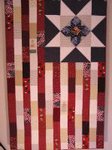Updated 3/2017-- photos/video and all links (except to my own posts) removed as many no longer active.
Earlier this week I read an article in Reader's Digest (November 2007 Issue) on Leon Fleisher and his focal dystonia of his right hand. The article is written by Oliver Sacks, MD and is a exert from his book "Musicophilia: Tales of Music and the Brain". I wanted to review what I knew about focal dystonia and ended up learning much. I would like to try to share this with you. Enjoy this "Ravel Piano Concerto for the Left Hand 1/2" played by Leon Fleisher (video).
The term dystonia collectively refers to a heterogeneous group of movement disorders characterized by sustained involuntary muscle contractions that result from co-contracting antagonistic muscles and overflow into extraneous muscles. Focal dystonias are adult-onset forms that affect a specific area of the body, ie hand, neck, vocal cords. Most focal dystonias are primary. By primary it is meant that the dystonia is the only neurological symptom.
The term dystonia collectively refers to a heterogeneous group of movement disorders characterized by sustained involuntary muscle contractions that result from co-contracting antagonistic muscles and overflow into extraneous muscles. Focal dystonias are adult-onset forms that affect a specific area of the body, ie hand, neck, vocal cords. Most focal dystonias are primary. By primary it is meant that the dystonia is the only neurological symptom.
Focal hand and limb dystonia usually begins as a painless loss of muscular control in highly practiced movements. A genetic predisposition is thought to occur in less than 5% of all cases of focal dystonia. There are many professions that require repeated and intricate hand movements. However, focal hand dystonia is more common in musicians than any other group of professionals, including dentists, surgeons, and writers. This disorder is often referred to in medical literature as occupational cramps (ie, “violinist’s cramp”, “pianist’s cramp”, "writer's cramp"). (photo credit)
Cause
There is no one isolated cause of hand and limb dystonia. A variety of pathological conditions may lead to similar symptoms. As a child develops, he/she learns many different movements (such as walking, writing, or playing an instrument) that are stored in the brain as motor programs. Instances of hand dystonia that are highly task-specific have been described as a “computer virus” or “hard drive crash” in the sensory motor programs that are essential for playing music. However, additional factors, such as a genetic predisposition, are likely to play a significant role in the development of such a sensory-motor dysfunction. Why this “computer virus” cannot be easily overcome by establishing a new and improved sensory-movement pattern remains an important question for researchers.
There is no one isolated cause of hand and limb dystonia. A variety of pathological conditions may lead to similar symptoms. As a child develops, he/she learns many different movements (such as walking, writing, or playing an instrument) that are stored in the brain as motor programs. Instances of hand dystonia that are highly task-specific have been described as a “computer virus” or “hard drive crash” in the sensory motor programs that are essential for playing music. However, additional factors, such as a genetic predisposition, are likely to play a significant role in the development of such a sensory-motor dysfunction. Why this “computer virus” cannot be easily overcome by establishing a new and improved sensory-movement pattern remains an important question for researchers.
Symptoms
Most affected persons describe symptoms in terms of their occupation terms. A musician may notice
Most affected persons describe symptoms in terms of their occupation terms. A musician may notice
- Subtle loss of control in fast passages
- Lack of precision
- Curling of fingers
- Fingers “sticking” to keys
- Involuntary flexion of bowing thumb in strings
A writer may notice:
- Deterioration in neatness or speed of writing or just clumsiness
- A cramp or aching in the hand on writing
- May report that the hand freezes up on attempting to write
- Difficulty in moving the pen across the page
A tremor may or may not be associated with the spasms. In most cases, the dystonia is present only in the context of specific tasks (and may be very specific to one instrument--a clarinet but not a saxophone). The dystonia may appear extremely sensitive to sensory input: a pianist may experience symptoms while playing on ivory keys but not while playing on plastic keys. Sometimes the modification of posture and even facial expressions may affect dystonic spasms in the hand.
Physical Exam
Inspection
No special examinations are described for focal dystonia other than inspect the patient performing his task.
- The pen commonly is held very tightly, with an exaggeration of the normal semiflexed posture of thumb, index and other fingers, and with hyperextension of the distal interphalangeal joint of the index finger. Occasionally, the hand suddenly stops and the paper is perforated, or it might dart across the page with a sudden jerk. The script produced is usually abnormal. Tremor is a common finding in all forms of writer’s cramp but it is usually not severe. (photo credit)
- Examination of the musician while playing reveals non-physiologic posture and gestures in most of the patients. Sometimes it is possible to identify involuntary dysfunction such as flexion, curling in one or two fingers, or involuntary extension of the “sticking fingers”. These may be difficult to detect, even with slow motion video.
The remainder of physical examination is often normal, but subtle findings can be noted in some patients: dystonic postures of the affected limb when the patients sit or walk, or loss of arm swing of the affected side during the gait.
Palpation
There is minimal unilateral increase in muscle tone in some patients. There are no other abnormal findings.
Quantification
The Fahn-Marsden scale was designed to quantify generalized or focal dystonia and can be found here.
Electromyography
Electromyography studies show prolonged duration of muscle bursts with superimposed shorter, repeated bursts of activity. The pattern is of complete lack of selectivity for individual muscles with overflow of contraction to muscles not normally activated by the task being performed. Electromyography may also useful as a guide to botulinum toxin injections.
X-rays
Radiographs are not useful in the assessment of focal dystonia. Occasionally, in an appropriate setting, magnetic resonance image of the brain can be useful to rule out a cerebrovascular disease.
Treatment
There is no cure for dystonia at this time, and although treatment of the disorder may be challenging, there are several available options. The different causes of hand dystonia may warrant different treatments. Don't give up--see Leon Fleisher's story.
There is no cure for dystonia at this time, and although treatment of the disorder may be challenging, there are several available options. The different causes of hand dystonia may warrant different treatments. Don't give up--see Leon Fleisher's story.
Oral medications: There are a number of therapeutic agents with clear beneficial effects to writer’s cramp, including anticholinergics, clonazepam and benzodiazepines. High dosage of anticholinergic drugs is firstly recommended for the treatment of dystonia.
- Doses recommended of biperiden are 2 mg per oral two or three times a day and titration to 16 mg a day.
- Diazepam is another choice. However, it is rarely adequate when used as sole agent. Doses are 10mg per oral two or three times a day.
- Clonazepam can be useful for improvement of phasic symptoms in cases with myoclonus and/or tremor. Doses are 0.25 mg per oral twice a day, increasing to 0.125 to 0.25 mg every three days up to a dose of 4 mg/day.
Botulinum toxin injections has been used for the treatment of writer’s cramp with good results. Its application requires careful and precise technique. The selection of the muscle should be based on careful physical examination while the patient writes or plays in order to trigger the dystonic movements. The injection should be carried out under EMG guidance with a hollow recording needle and the botulinum toxin is injected through the same needle. Small volume injections into multiple sites are preferred to a single large injection. Dose per muscle varies from 2.5-25 units. Initially, only few muscles are injected. The dose per muscle and number of muscles injected are optimized (based on response) for subsequent injections.
Splints
Some patients find that finger-splinting device made individually according to their symptoms help improve their ability to write or to play a musical instrument. Limb immobilization for four weeks and a half is a simple and sometimes effective treatment for this condition. (photo credit)
"Therapeutic approaches involving the practice of movements are likely to remain unsuccessful unless their design includes a framework that, in principle, aims at interrupting this vicious circle. Indeed, a recently developed behavioural therapy, termed sensory motor retuning, holds great promise (Candia et al., 2002 ). Musicians with focal hand dystonia performed repetitive movements with fingers of their dystonic hand while one or more fingers except the dystonic ones were immobilized. After therapy, movements of the dystonic fingers were substantially better controlled, with some musicians reaching near-normal performance levels. Along with improvement of motor behaviour, the topography of the somatosensory representation of the fingers became normalized." from Brain article (see references below).
). Musicians with focal hand dystonia performed repetitive movements with fingers of their dystonic hand while one or more fingers except the dystonic ones were immobilized. After therapy, movements of the dystonic fingers were substantially better controlled, with some musicians reaching near-normal performance levels. Along with improvement of motor behaviour, the topography of the somatosensory representation of the fingers became normalized." from Brain article (see references below).
For an interesting list of people who have struggled with this problem, check here.
References and Resources
Mark Hallett, MD
NIH clinical study "A Training Protocol for the use of Botulinum Toxin in the Treatment of Neurological Disorders", reference No. 85-N-0195
Focal Dystonia of the Hand by Marcos Sanmartin
Focal hand dystonia – a disorder of neuroplasticity?; Brain, Vol. 126, No. 12, 2571-2572, December 2003; Joseph Classen
Upper Limb Disorders in Musicians by Raoul Tubiana, MD
Tubiana R. Musician’s focal dystonia. Hand Clin 19: 303-308, 2003.
Dystonia Fact Sheet--National Institute of Neurological Disorders and Stroke
Dystonia--pianomap
Focal Dystonia from a Guitarist's Perspective by Jarrod Smerk
A Tale of Two Hands--Charlie Rose talks to pianist Leon Fleisher
Muscians with Dystonia Foundation







1 comment:
Thank you for such a thorough treatment of focal dystonia, but especially thanks for showcasing Leon Fleisher. Fleisher is a god among pianists and is a national treasure. It seems an impossible task, but his pedagogical career actually rivals the greatness of his performing one--so many of his students have gone on to flourishing careers.
The left-hand repetoire for the piano was neither forgotten nor 2nd rate as the Rose article makes it seem. In fact, many LH works are massive technical hurdles (Godowsky's pieces, especially) not taken lightly. Fleisher did sort of champion a mini-revival of that literature.
Fleisher's is a great human spirit story that one never tires of hearing.
Post a Comment